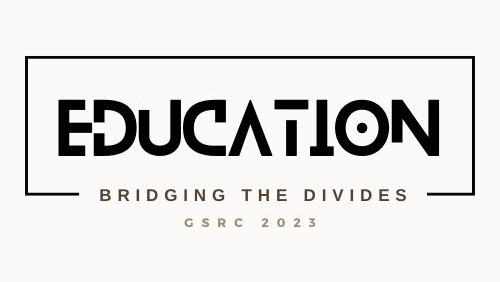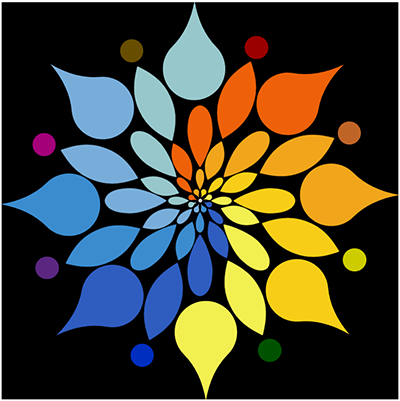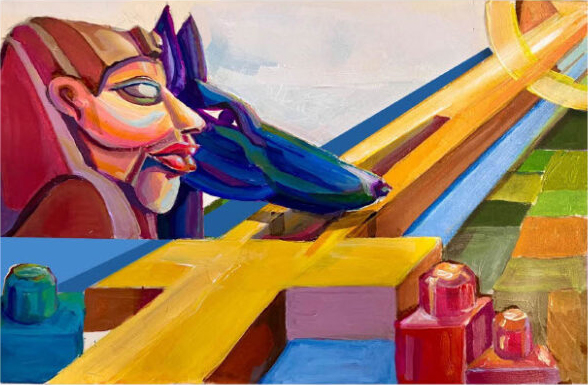Conference Gallery (2023)
“For Past Me, For Future You”
Second Place
One word stuck out to me from this year’s OISE GRSC theme, which was “transformation”. As someone who dabbles in various art forms, in my opinion, the most literal and transformative type of art would be origami. The art of folding paper.

I thought it incredibly ironic yet fitting to make an art piece about Education out of paper, as you gain a VERY expensive one at the end of your chosen degree. I folded the individual pieces and took photos of them to edit together for the final piece.
I used other symbols of transformation and voyage such as paper clouds, butterflies, planes, and bright floating balloons. All symbols are pointed upward to some degree to represent the upward trajectory of the graduate.
The core characters of this piece are a parent and their child. The parent is looking up at the sky, their face blank to let the viewer decide how they would feel after such an achievement. Whether that be fear, excitement, relief, or all three at once. The child is handing them balloons in celebration, bright yellow to symbolize youth and hope. The blue and brown building stands sharp behind them. I chose to portray a parent and a child to represent our older students and those who are working towards a brighter future not just for themselves, but for their loved ones. Other balloons are also spotted in the distance. As other families release their dreams and aspirations into the sky in celebration. Almost as if sending a token above the clouds, wishing for an auspicious future.
Silvia Nguyen is pursuing her MEd in Adult Education and Community Development and works professionally in higher education. As a first-generation graduate from an immigrant family, she considers it a privilege to support other students in post-secondary and to have the opportunity to pursue further education. Silvia also believes in art and creativity as an avenue for conscientious engagement with social issues. She engages in various sustainable art projects with friends and community members in her spare time.
Silvia’s interactions with her students drive her research towards improving transitions and experiences of minority, mature, and/or ESL students. Her specialization in Workplace Learning and Social Change leads her to interrogate how the value assigned to newcomers’ qualifications and knowledge are linked to their ability to thrive in Canada. She looks forward to further study into how newcomers’ existing knowledge, education, and professional experiences can be nurtured and how discriminatory policies can be mitigated. Silvia seeks to use education research to advocate for the recognition of newcomers’ qualifications and create accessible re-qualifying degree and certificate programs. Her specialization in Workplace Learning and Social Change also supports her research into navigating the power structures that govern newcomers’ experiences in Canadian post-secondary and professional environments.
“Education”
Third Place
Education is central to this year’s theme placing it at the heart of the design and letting it be the focal point of the image. The word is encased by a simple border that does not draw to a complete close. This is where education must bridge the

divide, as demonstrated by the use of words.
The logo features a colour scheme that was kept to simple dark tones against a pale background for clear visibility showcasing the theme of the conference and keeping the focus on the word elements.
Just outside the logo, Graduate Student Research Conference (GSRC) and year are placed proudly highlighting the conference affiliation and designating the year the conference is being held. The lettering of the word education was done in a way where the word can be read yet there are still pieces to fill in to make for a clear iteration of the word. The strategic use of missing pieces was done to showcase the need for continued research to fill in the gaps in our learning and understanding in the field.
Moreover, while the missing pieces in the word education is left for the reader to decide what it might look like and it is up to the reader to picture what ‘education’ might look like. This represents the idea that for those attending and participating in this conference it is up to them to picture what education might look like as it bridges the divide and is the transformative tool for our future.
Jasmine Biloki is an Assistant Registrar at Victoria college at U of T completing a Master of Education in Higher Education within the student development and student services stream. Jasmine’s work involves enabling undergraduate students to reach their career goals, assisting them in gathering and processing the information needed to engage in academically related career planning. Helping people to find meaningful employment opportunities has defined Jasmine Biloki’s career. She has counselled youth with disabilities as well as individuals struggling with mental health or addictions as they seek employment. And now, her focus is helping Vic students in bridging their undergraduate academic work with further education and career planning. Her research interests are pathways within higher education and labour makers and higher education policy. In her free time, she volunteers with a local high school youth group and is an avid baker.
“Surya & Chandra” (Sun & Moon)
Honourable Mention

In order to co-construct new transformative pathways forward, through, by and for education, we must acknowledge the contributions of often-silenced and/or ignored communities.
For my artwork design, I was inspired by larger, often overlooked, communities of everyday women artists in India, South Asia and the diaspora, who create elaborate mandalas, kollams or rangoli with rice flour outside of their homes every morning in order to bring prosperity and well-being to their families and friends. The rice simply is eaten by ants, and other animals, generating no waste, and making space for brand new designs the next day.
Therefore, I have created a mandala in the form of an interwoven Sun and Moon. Herein, the ‘Light’ blends seamlessly into the Dark, and the Dark, then, intrinsically returns into the Light. One cannot exist without the other, much like we cannot exist without one another, nor can we exist without nature. I argue that we must accept our inner and outer ‘dualities’ – the Light and the Dark – in order to create a unified ‘singularity’ or set of common understandings within education. This does not, however, erase our sense of individuality; rather, it only enhances our collective pool of talents. So, to bridge our ‘divides’, we must recognize our unique gifts and diverse ways of knowing – as illustrated by a colour wheel of ‘dots’ along the edges of the mandala. Overall, I hope that this mandala represents the circularity and regeneration within our lives as educators, as researchers, as global ‘citizens’, as activists, as learners and, most importantly, as humans who share Mother Earth equally with all other beings.
My name is Vidya Sri (she/her). I recently graduated from the University of Toronto with a Master’s of Education in Adult Education and Community Development, specializing in Workplace Learning and Social Change as well as South Asian Studies. I am an English language instructor/facilitator, fitness instructor, singer, musician and visual artist. Currently, I am working as a research assistant for Dr. Katherine Entigar within the Department of Leadership, Higher and Adult Education. I am interested in the decolonization of our education systems through reflexive storytelling, oral narratives, embodiment, and other collaborative arts-based methodologies which foster the co-construction of new knowledges. I identify as a cisgender, Brown-skinned, Tamil, South Indian-Canadian, bisexual woman. As such, I always look for opportunities to truly represent these various aspects of myself in my teaching, research, art and music. For example, the mandalas in my artwork are inspired by the [often] overlooked communities of everyday women artists in India, South Asia and the diaspora who create elaborate kollams, or rangoli with rice flour outside of their homes every morning. Within the coming months, I hope to travel abroad in order to continue growing as a teacher, as a researcher, and as a lifelong learner.
“Unlock the Future”
Honourable Mention
The Artwork is designed to welcome the past elders to create the bridge extended to the future, this bridge of learning is an invitation for the present youth and expands for the upcoming generation future generation seen in the building blocks. The juxtaposition design is inspired from the ancient Egyptian concept of the afterlife.

This painting is made specifically to align with the conference theme of “Bridging the Divides: Transformation Through, By and for Education” symbolizes the importance of culture transitioning through time and history. Knowledge is power, but who has the power(knowledge) that opens the door of life? The angled Ankh “The key of Life” مفتاح الحياة connected diagonally from the building blocks to the sun, this key was held by the pharaohs to represent the power to sustain life, to revive human souls afterlife, the key is a metaphor for the education needed to open the door of knowledge and power, knowledge held collectively by the community to create the sense of future vision to togetherness and belonging. The land illustrated to represent a futuristic approach to honor the indigenous land, this key, the key of life for many cultures, opened the door to self-awareness and refusal of damage. The cultural transformation over time is when identities are empowered in solidarity accepting the differences between shapes, lines and color used.
The young generations are building the blocks of the future, The unprecedented time of cultures colliding to reduce the gaps other people created.
Marianne Botros (she/her) is an Egyptian/Canadian contemporary visual artist, muralist, therapeutic art practitioner and art educator. Marianne received her MEd degree in the Adult Education and Community Development program at Ontario Institute for Studies in Education OISE, University of Toronto, and has received a B.A.SC in Applied Arts and Science. She is currently working as a Teacher Assistant and Guest Lecturer in the Department of Visual Studies.
She participated in the “2022 Work From Home” Art Exhibition, at the Latcham Art Center, she was recently selected as one of the winners of the “Ethnic Diversity Legacy Bench” project, funded by the Stouffville Chamber of Commerce, choice grant 2023.
Marianne is passionate about facilitating Art-based Community programs and workshops believing that it enhances self-expression, stigma and allows exploring different cultures by co-cultivating art interventions to align with each participant’s needs. Marianne finds art as a process that improves mental and physical well-being, she also believes that art-related activities enhance cooperation, collaboration, and emotional regulation.